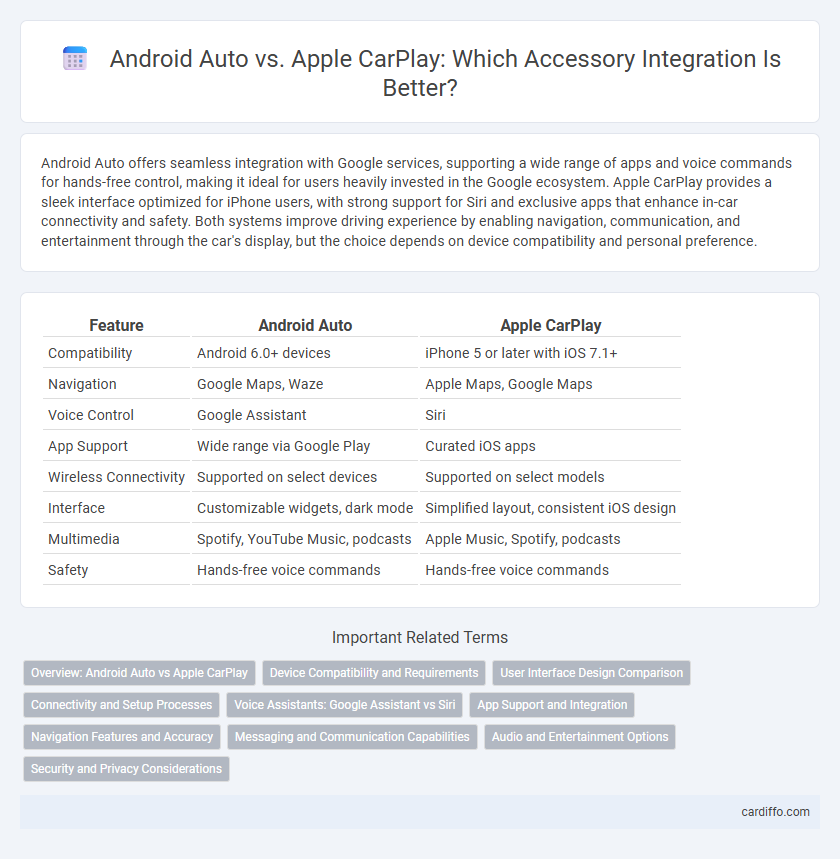Android Auto offers seamless integration with Google services, supporting a wide range of apps and voice commands for hands-free control, making it ideal for users heavily invested in the Google ecosystem. Apple CarPlay provides a sleek interface optimized for iPhone users, with strong support for Siri and exclusive apps that enhance in-car connectivity and safety. Both systems improve driving experience by enabling navigation, communication, and entertainment through the car's display, but the choice depends on device compatibility and personal preference.
Table of Comparison
| Feature | Android Auto | Apple CarPlay |
|---|---|---|
| Compatibility | Android 6.0+ devices | iPhone 5 or later with iOS 7.1+ |
| Navigation | Google Maps, Waze | Apple Maps, Google Maps |
| Voice Control | Google Assistant | Siri |
| App Support | Wide range via Google Play | Curated iOS apps |
| Wireless Connectivity | Supported on select devices | Supported on select models |
| Interface | Customizable widgets, dark mode | Simplified layout, consistent iOS design |
| Multimedia | Spotify, YouTube Music, podcasts | Apple Music, Spotify, podcasts |
| Safety | Hands-free voice commands | Hands-free voice commands |
Overview: Android Auto vs Apple CarPlay
Android Auto and Apple CarPlay are leading in-car infotainment systems designed to mirror smartphone capabilities on vehicle displays, enhancing driver convenience and safety. Android Auto integrates seamlessly with Android devices, offering Google Maps, Google Assistant, and a wide range of third-party apps, while Apple CarPlay provides intuitive access to iPhone features such as Apple Maps, Siri, and Apple Music. Both platforms support voice control, messaging, navigation, and media playback, but they differ in interface design and compatibility with specific vehicle models.
Device Compatibility and Requirements
Android Auto supports a wide range of Android smartphones running Android 6.0 (Marshmallow) or higher, requiring a USB connection or wireless compatibility depending on the vehicle. Apple CarPlay is compatible with iPhones running iOS 7.1 or later, primarily needing a Lightning cable or wireless support in newer car models. Both systems demand specific head units or factory-installed infotainment systems for seamless integration and optimal user experience.
User Interface Design Comparison
Android Auto features a customizable home screen with large, easy-to-read icons designed for minimal distraction, while Apple CarPlay offers a grid-style layout closely resembling the iOS home screen for familiarity and ease of use. Both interfaces prioritize voice control integration through Google Assistant and Siri, respectively, enhancing hands-free operation for safer driving. The choice between Android Auto and Apple CarPlay often depends on user preference for visual layout and seamless integration with their smartphone ecosystem.
Connectivity and Setup Processes
Android Auto offers seamless wireless connectivity on compatible devices, supporting quick setup via Bluetooth and Wi-Fi, while Apple CarPlay primarily requires a wired USB connection for initial setup, enabling wireless use on select iPhone models after. Both platforms integrate with vehicle infotainment systems, but Android Auto's broader device compatibility simplifies use across various Android smartphones. Apple CarPlay emphasizes a streamlined, user-friendly interface with tight iOS ecosystem integration, whereas Android Auto provides customizable settings and Google Assistant support for enhanced voice control.
Voice Assistants: Google Assistant vs Siri
Google Assistant on Android Auto offers seamless voice command integration, enabling users to send texts, navigate, and control media hands-free with high accuracy and natural language processing. Siri on Apple CarPlay provides robust voice control tailored for iOS devices, allowing users to make calls, send messages, and interact with apps through straightforward voice commands. Both voice assistants enhance driving safety by minimizing manual interactions, but Google Assistant's wider range of third-party app compatibility gives it an edge in versatility.
App Support and Integration
Android Auto offers extensive app support with seamless integration of Google Maps, Spotify, and WhatsApp, providing a versatile experience tailored to users' customization preferences. Apple CarPlay prioritizes a smooth, intuitive interface with optimized support for Apple-exclusive apps like Apple Music, Messages, and Podcasts, ensuring consistency across iOS devices. Both platforms continually expand their app ecosystems, but Android Auto's broader third-party app compatibility contrasts with CarPlay's tighter integration within the Apple ecosystem.
Navigation Features and Accuracy
Android Auto offers seamless Google Maps integration with real-time traffic updates, voice-guided navigation, and alternative route suggestions enhancing driving accuracy. Apple CarPlay leverages Apple Maps, featuring turn-by-turn directions, speed limit alerts, and proactive rerouting to avoid congestion. Both systems prioritize user safety and convenience, but Android Auto's access to broader map data often provides more detailed navigation and faster updates.
Messaging and Communication Capabilities
Android Auto offers seamless integration with Google Messages, WhatsApp, and other third-party apps, enabling voice-controlled texting and hands-free calls for safer communication on the road. Apple CarPlay supports iMessage, WhatsApp, and other popular messaging platforms through Siri, providing effortless voice dictation and message reading to minimize distractions. Both systems prioritize driver safety by allowing hands-free messaging, but Android Auto's broader app compatibility may appeal more to users with diverse communication preferences.
Audio and Entertainment Options
Android Auto offers seamless integration with Google Play Music, Spotify, and YouTube Music, providing extensive audio streaming options and voice-controlled access to entertainment apps. Apple CarPlay supports Apple Music, Pandora, and Audible, delivering a smooth interface with Siri voice commands for hands-free audio control and podcast playback. Both platforms enable access to radio apps like iHeartRadio and TuneIn, ensuring diverse entertainment choices while driving.
Security and Privacy Considerations
Android Auto and Apple CarPlay both prioritize user security by encrypting data transmissions and restricting app access to minimize risks of unauthorized data breaches. Apple CarPlay emphasizes privacy through strict app vetting and limits on data sharing, ensuring user information remains confidential. Android Auto provides customizable security settings, allowing users to control permissions and enhance protection against potential cyber threats.
Android Auto vs Apple CarPlay Infographic

 cardiffo.com
cardiffo.com